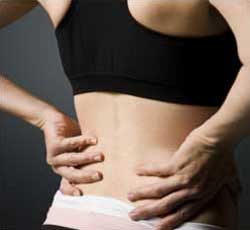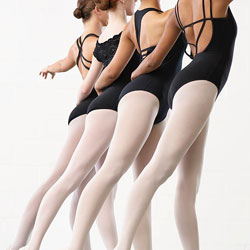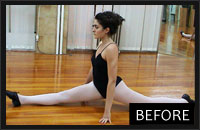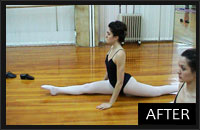
Dance and Physiotherapy
Harmonious movement and the perfection of the natural articulation of joints have, for many years now, been a focus of extensive research and study for us, and form the major objectives which we aim to achieve as a specialist physiotherapy studio.
The sensitive nature of dance performers is as a whole an especially captivating area of study, and is one in which we are able to offer appropriately specialized therapies.

Statistics from the Nureyev Foundation show that:
- 90% of dancers suffer from creaking in their hip joints
- 89% from bunions of the first metatarsophalangeal joint
- 31% have or will suffer stress fractures
- 17% of dancers over the age of 40 will suffer from arthritis
- 15-20% have spondylolysis (damage to the spinal vertebrae)
- 24% of (mainly female) dancers have scoliosis (abnormal curvature of the spine)
- 49% of the problems dancers experience with their knee joints are related to the patella (knee cap).
Following our studies and research, and the application over many years of the specialized kinsiotherapy techniques of the Trigger Point method as presented by Janet Travell & David Simons, and Manual techniques for the pelvic bones, we have observed remarkable improvements with increased flexibility of muscles and range of motion of between 30% -100% within a minimal period of time in dancers, dance school students, and professional dancers, independent of age.

The combination of the above techniques facilitates
- significantly increased flexibility,
- significantly increased strength,
- significantly increased speed of muscle contraction,
- reduction of pain in muscles which have sustained injury in the past, such as strains and contusions of the adductor muscles of the hip and the tibial muscles
- improvement in the speed of movement, jumps and leg extensions of dance students and professional dancers.
Strains (overuse syndrome) of the gastrocnemius (calf) muscles in professional dancers from choreographies in:
- Classical ballet with repeated pointe work
- Flamenco
- Tap Dancing
- Tango
Our physiotherapy studio is always on hand to help with dancer’s problems, such as:
- Spinal disc problems (cervical syndrome-lumbago-sciatica)
- Strains of the quadriceps (thigh) muscles, adductor muscles, hamstring muscles and the gastrocnemius (calf) muscle
- Ankle sprains
- Stress fractures
- Bunions
- Fallen arches
- Cartilage injuries in the knee cap
- Genu recurvatum
- Anterior Cruciate Ligament (ACL) and meniscus surgery rehabilitation
- Congenital hip dislocation
- Back and shoulder pain etc.
Application of the Manual Technique to the pelvis to restore the ischium to the correct position in a professional dancer
About Us...
Harmonious movement and the perfection of the natural articulation of joints have, for many years now, been a focus of extensive research and study for us, and form the major objectives which we aim to achieve as a specialist physiotherapy studio. The sensitive nature of dance performers as a whole is an especially captivating area of study, and is one in which we are able to offer appropriately specialized therapies.
Announcements
Our official facebook page is now online and waits for you! Click on like and be the first to learn anything about dancing, dancers, physiotherapy and the improvement of all forms of dance moves!
Physio Art Center proudly informs you that the physiotherapist and founder of the center, Adriani Nikolaidou, has received from the Industrial Property Organization the patent certificate with the title of: Method of increase of the openings of dancers and athletes in the lower ends resulting to the…










